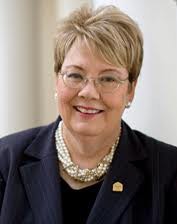Besieged by a barrage of hate incidents and propaganda efforts by White supremacists, colleges and universities must lead authentic discussions about troubling aspects of the nation’s racial past in order to secure a better future.
That is one of several themes that emerged among higher education administrators, student activists, Congressional leaders and scholars during recent discussions on the issue of racial climate on America’s college campuses and to probe ways to combat hate.
 Dr. Teresa Sullivan, president of University of Virginia participated in a Congressional forum titled, “Affirmative Action, Inclusion, and Racial Climate on America’s Campuses.”
Dr. Teresa Sullivan, president of University of Virginia participated in a Congressional forum titled, “Affirmative Action, Inclusion, and Racial Climate on America’s Campuses.”“In order for us to have a successful future, we have to be comfortable with being uncomfortable, which means having real conversations about our shortcomings as a nation in the past,” said Payton Head, former student body president at the University of Missouri and a fellow at the National Campus Leadership Council.
“If our educational institutions pretend there is no problem, we won’t have the opportunity to create solutions,” said Head, who was student body president at Mizzou during the protests that led to the ouster of the university system’s president in 2015.
Dr. Teresa Sullivan, president of the University of Virginia, listed a series of steps her institution has taken to acknowledge the fact that it was “built by the hands of enslaved labor.” Those actions include renaming campus buildings after individuals such as William and Isabella Gibbons, who were held in slavery by different UVA professors in the 1800s. “Acknowledging the past is one way for us to improve the racial climate and build a brighter future,” Sullivan said.
Head and Sullivan made their remarks Friday on Capitol Hill during a Democratic-led forum titled “Affirmative Action, Inclusion, and Racial Climate on America’s Campuses.”
The forum — led by U.S. Rep. Bobby Scott, D-Va., ranking member of the house committee on education and the workforce, and US Rep. John Conyers, Jr., D-Mich., ranking member of the house judiciary committee — sought to explore what, if anything, Congress can do to help create safer college campuses.
The issue has gotten more attention since the election of President Donald J. Trump but has become more urgent in the wake of the deadly Charlottesville protest that began at the University of Virginia last month.
A major challenge is to not encroach upon First and Second Amendment rights in the process, experts said.
Scott asked what colleges can legally do to deal with hate groups on campus that create racially hostile environments.
Sherrilyn Ifill, president and director-counsel at the NAACP Legal Defense and Educational Fund, said there needs to be a greater emphasis on the 14th Amendment, which guarantees equal protection under the law.
“We can’t just look at the First Amendment,” Ifill said, arguing that public universities have an obligation to make sure diverse groups — such as African Americans, Latinos, women and LGTBT individuals — are not subject to hostile environments that undermine their education.
Ifill also said that state-run universities “need to get serious about articulating their mission,” which she suggested should include preparing future leaders of the state who can engage with and problem-solve for diverse populations.
“Universities need to begin describing their missions in a way that necessarily demands diversity and environments where that type of interplay can happen,” Ifill said. Mission statements are important in litigation when a university’s affirmative action program is examined for how connected it is to the university’s mission statement.
Unfortunately, according to Richard Cohen, executive director at the Southern Poverty Law Center, the expression of racist views is protected speech.
“In our country, for better or for worse, you have the right to hate,” Cohen said. “You just don’t have the right to hurt people.”
He said there is “tremendous tension” between the First and Fourteenth Amendments.
“I don’t think there are any easy answers here,” Cohen said. “Hate groups are legal.”
“The key is for universities to have good policies that are articulated against a racially hostile atmosphere,” Cohen said, adding that students should know where to lodge a complaint to prompt an investigation that not only looks at specific incidents but the environments in which they were created.
He said he feared the Trump administration would turn away from such an approach.
In a separate talk at American University — which has been the site of several racial incidents as of late — panelists discussed what universities can do to curtail hate.
Several suggested that college is too late and that the education against hate must begin much earlier with children before they reach college.
Terri Johnson, executive director of the Center for New Community, a Chicago-based research and advocacy organization that tracks organized bigotry, said colleges and universities must reorient themselves to be institutions of “reeducation and places to combat miseducation so that we are creating citizens who are understanding this country and what it is and what it is not.
“And that is messy and ugly and hard, but if we don’t do it soon we’re going to continue to live in this cycle of reengaged hate and rebranded 21st century hate because we haven’t told the truth about who we are,” Johnson said.
“We are not just a land of immigrants, but a land of immigrants, genocide and slavery,” she said in reference to the slaughter of indigenous peoples and the enslavement of Africans in America.
Along those lines, Scott mentioned the “400 Years of African American History Act,” which would establish a commission to plan programs and activities in 2019 across the country to recognize the arrival and influence of Africans in America.
He said the bill, if passed, would help the nation “go over those years to explain what happened, how we got to where we are, and what we need to do in the future.”
Jamaal Abdul-Alim can be reached at [email protected] or you can follow him on Twitter @dcwriter360.


















